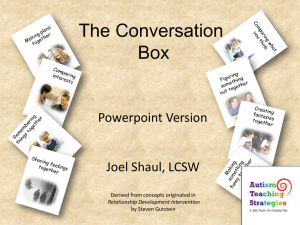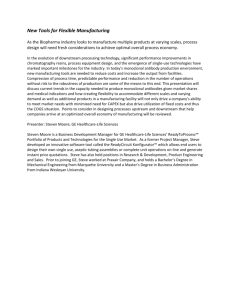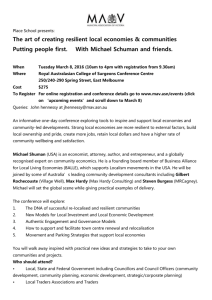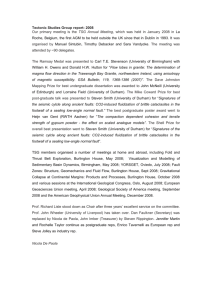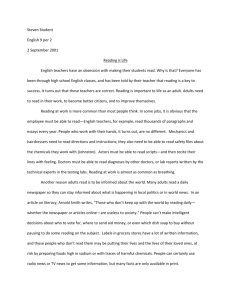In what ways do children with autism spectrum disorders (ASDs
advertisement
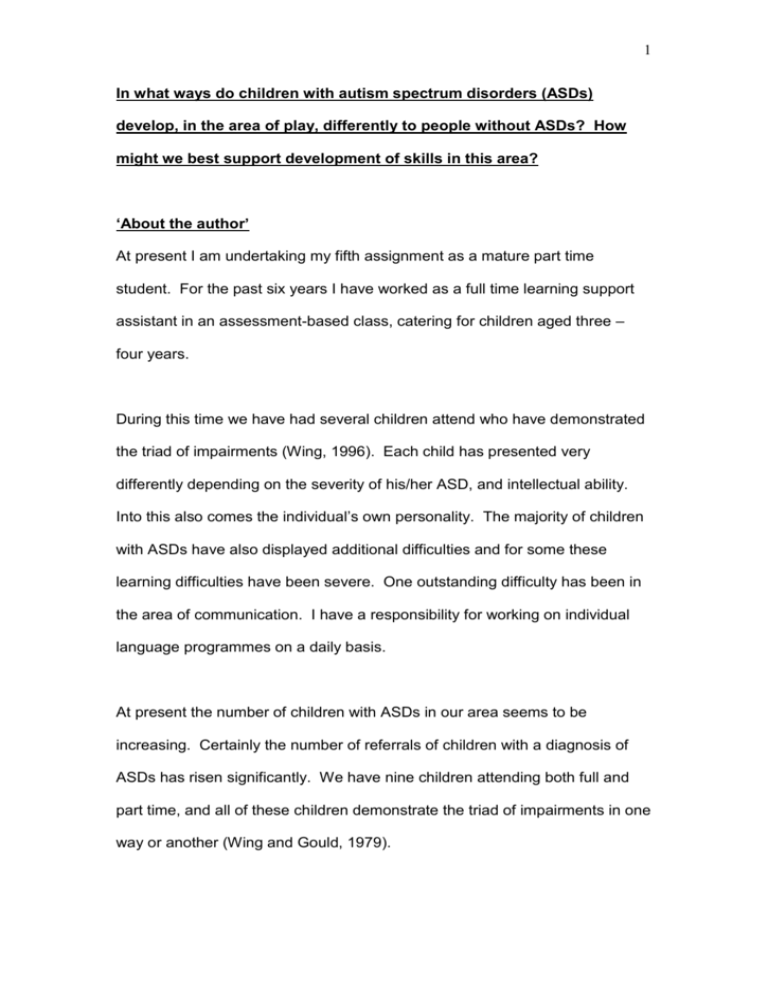
1 In what ways do children with autism spectrum disorders (ASDs) develop, in the area of play, differently to people without ASDs? How might we best support development of skills in this area? ‘About the author’ At present I am undertaking my fifth assignment as a mature part time student. For the past six years I have worked as a full time learning support assistant in an assessment-based class, catering for children aged three – four years. During this time we have had several children attend who have demonstrated the triad of impairments (Wing, 1996). Each child has presented very differently depending on the severity of his/her ASD, and intellectual ability. Into this also comes the individual’s own personality. The majority of children with ASDs have also displayed additional difficulties and for some these learning difficulties have been severe. One outstanding difficulty has been in the area of communication. I have a responsibility for working on individual language programmes on a daily basis. At present the number of children with ASDs in our area seems to be increasing. Certainly the number of referrals of children with a diagnosis of ASDs has risen significantly. We have nine children attending both full and part time, and all of these children demonstrate the triad of impairments in one way or another (Wing and Gould, 1979). 2 Introduction This assignment will focus on the development of play skills in children up to the age of 5 years. I will describe the key stages of development in children without ASDs and then compare this to a child with an ASD that I have observed within my work place. I will then suggest potential strategies that might support the child with an ASD in the development of play. Unless specially differentiated, children of both sexes are referred to throughout as ‘he’. I will be relating many play actions through observations within my working practice. For reasons of confidentiality I have changed the child’s name. The pace of play development Babies and children are naturally programmed to develop in a reasonably orderly sequence. They put on weight, grow, smile and laugh, develop teeth, learn to sleep through the night and then become risky little people as they start to crawl and walk around the furniture. In the early years children’s achievements and mile-stones come thicker and faster than ever again. Parents may feel tempted to take credit for these achievements – and so they should. No one denies the impact that a stimulating, loving and opportunityrich home life can have on children. 3 Children’s experiences mould them from birth, and in all probability prior to birth (Habel, 1998). Children develop and learn at different speeds – some faster, some slower. The pace at which a child can take on a new learning experience depends partly on their personality, genetic make-up and environment, and partly on any particular difficulties they may have. Play becomes a natural and necessary component for most children. It serves many important functions, including stress reduction, opportunities for socialization, outlets for aggression, personal growth and expression and diversion from the more serious pursuits of life (Western & Western, 1996). From earliest infancy, play is a primary way children learn (Kids Health, 2004). Through play, children explore their bodies, their relationships with their parents and peers, and the world around them. An older baby who repeatedly drops a block from his high chair is playing, but he’s also an amateur researcher. How did the block sound hitting the floor? Is the sound the same on the carpet? Who will pick it up? Play appears to emerge in an orderly developmental sequence as the child learns to use first his sensory and motor equipment to best advantage and later his powers of communication and creativity. Each step depends upon successful achievement of previous stepping-stones. Along with this he is able to explore new situations and model roles he has observed. If parents take an active part in their child’s play, play can help build self-esteem. A parent giving praise to child’s achievements also helps them learn that what they are doing is interesting and entertaining to the larger world. 4 Exploratory and manipulative play begins at about 3 months with finger play. If given an object e.g. a rattle, the child will hold it for a few moments and may move it towards their face. By 18-20 weeks he can reach for and grasp an offered rattle, look at it with prolonged gaze and shake it. He can drop it by opening both hands wide, but cannot yet place it down neatly and deliberately. By 6 months his hand eye coordination is so advanced that he is able to reach out for and seize hold of any play object within reach of his extended arms. Imitative play becomes more evident at approximately 7 months. He can now hold two objects, one in each hand simultaneously using a palmer grasp and brings both hands together to ‘match’ them. He can now pass a toy from one hand to the other with voluntary release. From about 8 months he sits steadily on the floor, stretches out in all directions for toys within arms reach without falling over, and begins to creep and reach towards eye-catching objects. By 9 months he begins to throw toys and enjoys producing noise by banging or sliding solid objects such as blocks on a hard floor. Having watched a playmate build a tower of blocks for him to knock over, he tries to imitate. Early play at this stage may remain endlessly repetitive unless the mother indicates the next step. By twelve months the child becomes increasingly mobile (many at this stage are able to walk), inquisitive and selfwilled. The kitchen for example provides many exciting, sometimes dangerous, possibilities for gathering everyday experiences, e.g. reaching up to the cooker to investigate the knobs. At 14 months the child will happily 5 enjoy putting objects in and out of a container improving their manipulative and imitative play. Constructive play begins at around the age of 18-20 months. He manipulates blocks with good pincer grasp but seldom aligns more than two or three together on the flat or in a ‘tower’ in imitation or spontaneously. As weeks go by, he pushes and pulls large wheeled toys and guides small ones by hand or on the end of a string. Eventually he will use his trucks to transport collections of objects from one place to the other. He begins to engage in short episodes of role-play, enjoying using replicas of familiar household objects e.g. shopping basket, sweeping brush, pots and pans. He will now also be managing to communicate his needs and feelings quite effectively, through large expressive gestures and an increasing repertoire of single words. He is able to begin to understand the facial expressions and reactions of familiar adults. He shows growing interest in naming objects and pictures, in repeating words and in listening to people talking (Sheridan, 1976). Make-believe (or pretend) play develops from approximately 24 months onwards. The child being given a chair and a steering wheel of sorts will usually make suitable engine noises. He will now extend earlier role-play by inventing little make believe domestic situations such as cooking and serving meals. These activities become increasingly organised and prolonged, and which he ‘Plays out’ with seriousness. At this stage his language skills will have developed and he will talk out loud, describing and explaining what he’s doing. After 2 1\2 yrs he will be prepared to admit one or two familiar children 6 briefly into his play world and to venture into theirs. Although they play in close proximity play is usually still a ‘solo’ type, each child needing it’s own individual toy. By the time the child reaches 3 years he is normally ready to work and play in a small group situation. During the next year he makes rapid strides in socialization, widening his circle of friends and making less demands for constant attention from his mother. The ability to cope and try new equipment becomes easier. He easily follows other children becoming more adventurous joining in with make-believe activities. Meanwhile, between 3 and 4 years a child’s ability to use spoken language rapidly improves. He is able to communicate with words as well as facial expression and telling gestures. The child of 5 years is now able to play with increasing enjoyment not only of elaborate make-believe, but also for complicated indoor and outdoor games, which require knowledge of rules and a sense of fair play. Play at this stage will have become very active, being able to relate to others and increasingly take on many new different environments. The autistic child and play Many autistic infants are different from birth. They are often described as either passive or overly agitated babies. A passive baby refers to one who is quiet most of the time making little, if any, demands on his parents. An overly agitated baby refers to an infant who cries a great deal without obvious cause, sometimes non-stop, during his waking hours. 7 For most children, the development of play follows a predictable course. Children with an ASD typically do not develop play skills in accord with the usual developmental pattern (Cumine, Leach and Stevenson, 2000). In children with ASD difficulties, play is often repetitive, sensory and isolated. When these children use toys in their play, they often play with a very limited range of toys and use them uncharacteristically e.g. spinning wheels, lining up cars, flicking or flapping cards. They lack in the area of imagination, a characteristic of the triad of impairments (Wing, 1996). There also appears to be a lack of social motivation, a limited use of functional language and lack of flexibility, all requirements for the development of play, particularly the social aspects. Edelson (2001) describes how these children can be considerably delayed in their development, many may never have any kind of pretend play and handle toys and other objects purely for physical sensations. Steven is a four-year-old child who has a diagnosis of ASD. He has been attending the Assessment class for several months. Over this time I have been making observations of his play skills. These observations have been made across different play experiences both in and out of the classroom setting. Steven’s mother described him as a very passive baby needing very little attention. He began to develop like any other child having an interest in several different toys. Single word speech developed but increasingly this faded away over time. 8 With the on set of Steven starting school he was a very silent child. Play times would see him sitting in the middle of the playground crossed legged, spending endless amounts of time dribbling his saliva and then proceeding to pull it up between his fingers as far as he could without breaking the connection. He remained completely silent and so preoccupied with his own activity that he did not appear to recognise that other children were running and playing around him. Should another child accidentally bump into him he would remain cross-legged and cry silent motionless tears, not making any attempt to look at the child for them to make an apology. Steven plays alone in the classroom setting with toys different from those used by other children. He prefers to find his own personal space, usually a corner of the room. Once in his space he has an unusual manipulation for small chosen objects, these being held up close to the eye and at the same time they will be twisted and turned from one angle to the other. During this activity he has recently started to produce sounds, which we presume are of pleasure. Should another child intervene Steven becomes agitated, moving away to regain his own personal space. Having left Steven without any adult intervention, on an observation basis, he spent long periods of time pursuing his own activity without making reference to others around him. Steven does not appear to see him self as a member of a particular group. He follows his own agenda rather than that of a group of children in the playground or class. Recently in the playground Steven has started to stand by the door seeming to look without apparent purpose into space, however 9 should another child get on a bike Steven automatically appears to come to life. He will get up close to the bike wheels, watching them go round. There appears to be an act of self-stimulation, hands flapping, spinning, dribbling and an almost skipping action. Having made attempts on several occasions to get Steven on to a bike he becomes rigid, arching his back and pulls away from the adult who is trying to encourage. It appears that there is no stimulation towards the bike, only that of the wheels going round. At other times he will be seen to tip cars over, spinning the wheels as fast as he can and again becoming stimulated as described above. There have been times when Steven has appeared to show evidence of what seems like imagination. He will act out a sequence of events that he has invented. This usually occurs with cars being lined up and pushed along. This has looked convincing at first but prolonged observation shows that he is repeating the same sequence over and over again, without any changes. Repeatedly Steven will be alone in this activity. When another child does become inquisitive towards his activity or wants to be sociable with Steven, he will appear cross and at times lash out at the child. He also displays this behaviour towards an adult if we try to intervene. Attwood (1998) suggests that the ASD child will at times become abrupt and aggressive in ensuring their solitude. It was interesting to watch Steven in a recent game of bowls with the whole class group. Each child was in turn rolling the ball and consequently knocking down the bowls. However Steven ploughed through the group of children 10 collecting up the skittles and proceeding to line them up in particular colour order e.g. reds, blues etc. Several attempts were made to show Steven simplified rules of the game by visually modelling, however Steven continued to collect up the skittles. So the game could be continued we had to get another set of skittles out of the cupboard for Steven to play independently. This then reduced the frustration for his peer group. As time has progressed within the group setting we have introduced a simple game of hide and seek in the classroom. It is interesting to observe the children looking in all areas of the classroom for the hidden object. However Steven will continually return to the first hiding place, not seeming to understand or have the imagination that the object can be in a different place. Repeatedly we have shown Steven the object in different areas, but he still continues to return to the original hiding place. Functional play is the appropriate use of an object in play, for example brushing a dolls hair. With this activity set up, on a one to one basis, Steven was shown by first visual model then followed by hand over hand modelling. Steven appeared to be interested in the activity but then proceeded to take both doll and brush and throw them across the room. Many of the children enjoy the use of the home corner, initiating very early play skills by copying an adult. Steven however, will give a sideways glance at others playing, without joining in. 11 In the area of puzzles, shape and colour matching Steven becomes much more stimulated. He is very capable of sitting for long periods of time with a new puzzle. He will very often start from the middle and work outwards, not needing a model of the task beforehand. He is able to sequence numbers and will often sit on the floor building a tower counting out the numbers in a very slushy developing voice as he builds his tower further. He does not appear to become distressed should another child intervene and knockdown his tower. He will just proceed to rebuild and return to counting each block in turn. There is great stimulation in the area of music. He loves to be involved with music making. If we have instruments out as an activity Steven will be drawn straight away to this area. His accuracy for rhythm and time is amazing. Complicated patterns will be copied easily with a beater or with the hands when using a drum. During this time he will show signs of enjoyment good eye contact, approving facial expressions. His ability to copy finger and nursery rhymes is improving as the slushy voice tone develops. Wimpory and Harris (1992) point out that some children need objects to interest them in people. However we have to take care with selection and use. Strategies to help support play development Anticipation Play routines are those short repetitive games that often develop during early social play between adults and young children. They usually involve a build- 12 up of anticipation towards the key point and are called ‘tension-expectancy games’ (Nind and Hewett, 1994). Anticipation of a key point in a game or song is a sign that the child is truly engaged by it. Good examples of these are ‘peek-a-boo’ and ‘I’m coming to get you’. Most are created spontaneously, by repeating whatever a child enjoys. They are often spoken or chanted, with exaggerated playful intonation, and may be further enhanced by musical accompaniment. Such games often involve physical contact. Despite varying degrees of sensitivity to touch, Steven does enjoy being lifted and even tickled. We have been working on three key areas with Steven, Building up the tension, then pausing silently just before the key point e.g. the ‘boo’ allows Steven to anticipate. Responding to his signs of anticipation by continuing the game immediately, as if he had said the word, enables Steven to take a turn. Repeating the game in a similar way helps him to indicate intentionally that he wants it to continue. Play routines can be captured in many games using toys and props, even where physical active play is not possible or appropriate. For example, we use scarves dropping them onto the child’s head, with the words, ‘where’s Steven’? We would wait for some anticipation, or Steven removing the fabric saying ‘There he is’. These games are most effective if the language is timed to coincide exactly with the actions. Developing imagination skills for play Steven manipulates the wheels of a toy but does not play with it imaginatively. 13 Strategies Teach play skills by modelling what he can do with different toys. If possible, have two identical toys and encourage him to copy you. Use toys that capture his interest, such as puppets, bubbles, cars with sirens balls with bells inside and so on. Teach pretend play using the home corner, construction equipment etc. Show repetitive actions and introduce a limited number of key words or sounds. Take everything step by step and us lots of repetition and prompting. When he has learnt a play routine, invite another child to join in. Structuring routines with toys Decide on your aim: e.g. taking turns, imitating, or requesting (nonverbally or verbally) Choose a toy that gets your child’s attention Decide on the roles: what you will do and what you want your child to do Decide on the steps for the routine: e.g. (this is just one possible example) 1. Have bricks in container 2. Get child to sit near you 3. If appropriate, have visual cards of the activity available 4. Shake container to get child’s attention 5. Wait for the child to show response (e.g. look, touch container, or vocalise) 6. When child responds, open container and say ‘Bricks! 14 7. Wait for child to show response (e.g. reach for brick or say ‘brick’) 8. When child responds, give one brick and say ‘Brick’ 9. Encourage (or prompt) child to build bricks into a tower 10. Wait for child to show a request for another brick – say ‘More brick?’ 11. Build up the suspense until the tower begins to wobble – say ‘Bricks fall down!’ 12. Encourage (or prompt) the child to put the bricks back into the container – say ‘Bricks away’ (or something similar) 13. Repeat the routine until the child tires of it – then put the lid on the container – say firmly ‘Bricks finished!’ 14. If appropriate, remove visual card from view Conclusion References to text, describe the development of play in the child with an ASD is likely to show a different pattern from that of a normally developing child, since one part of the triad is lack of social imagination, and this affects the development of play (Wing, 1996). The child is more likely to choose to play with an object than with another person – although he may well enjoy rough and tumble games. The obsessional preferences of children with ASD often make their play repetitive. The child may play repeatedly with the same toy, line up toys, or become obsessed with a small part of a toy (such as the wheel of a toy car). Due to their lack of imagination, creative and pretend play are slow to develop, and may never develop very far. 15 It is important that we teach the child to share attention, firstly with another person, and then with that person and a mutually interesting toy or activity. These joint attention skills can be developed using routines: firstly sharing attention with an adult in a social routine, then sharing an activity or toy with the adult in a joint action routine. Using routines is an enjoyable way to teach the child about social interaction, but these do have to be taught overtly. It may be necessary to introduce further activities or toys, so that the child learns to generalize sharing skills. It is important to remember that children with ASD do need to be taught play skills, but they will also need some time to enjoy pursing their own choice of play activity – alone if they so choose – as leisure activity – to allow for tension release and most of all enjoyment. References Attwood, T. (1998) Asperger’s Syndrome a guide for parents and professionals. London and New York: Jessica Kingsley. Cumine, V. Leach, J. and Stevenson, G. (2000) Autism in the early years. London: David Fulton. Edelson, S (2001) Overview of autism: Visited 4/10/01 http://www.autism.org/overview.html. Grandin, T. (1995) Thinking in pictures. New York: Doubleday. Habel, A. (1998) Encyclopedia of child health. London: Octopus. Kids Health The power of play. Visited 1/6/04. http:// Kids health.org/parent/growth/learning/power play.html. 16 Nind, M. and Hewett, D. (1994) Access to communication: Developing the basics of communication with people with severe learning difficulties through intensive interaction. London: David Fulton. Sheridan, M. (1976) Spontaneous play in early childhood from birth to six years. London: NFER. Ltd. Western, D. and Western, M. (1996) Play ground therapy. Energy times, September 1996. Wimpory, D. and Harris, J. (1991) Get kids talking: encouraging early language development in children with developmental disabilities. British Institute of Learning Disabilities. Wing, L. (1996) The autistic spectrum: a guide for parents and professionals. London: Constable. Wing, L. and Gould, J. (1979) sever impairments of social interaction and associated abnormalities in children: epidemiology and classification, J of autism and developmental disorders, 9, 11 – 29.
